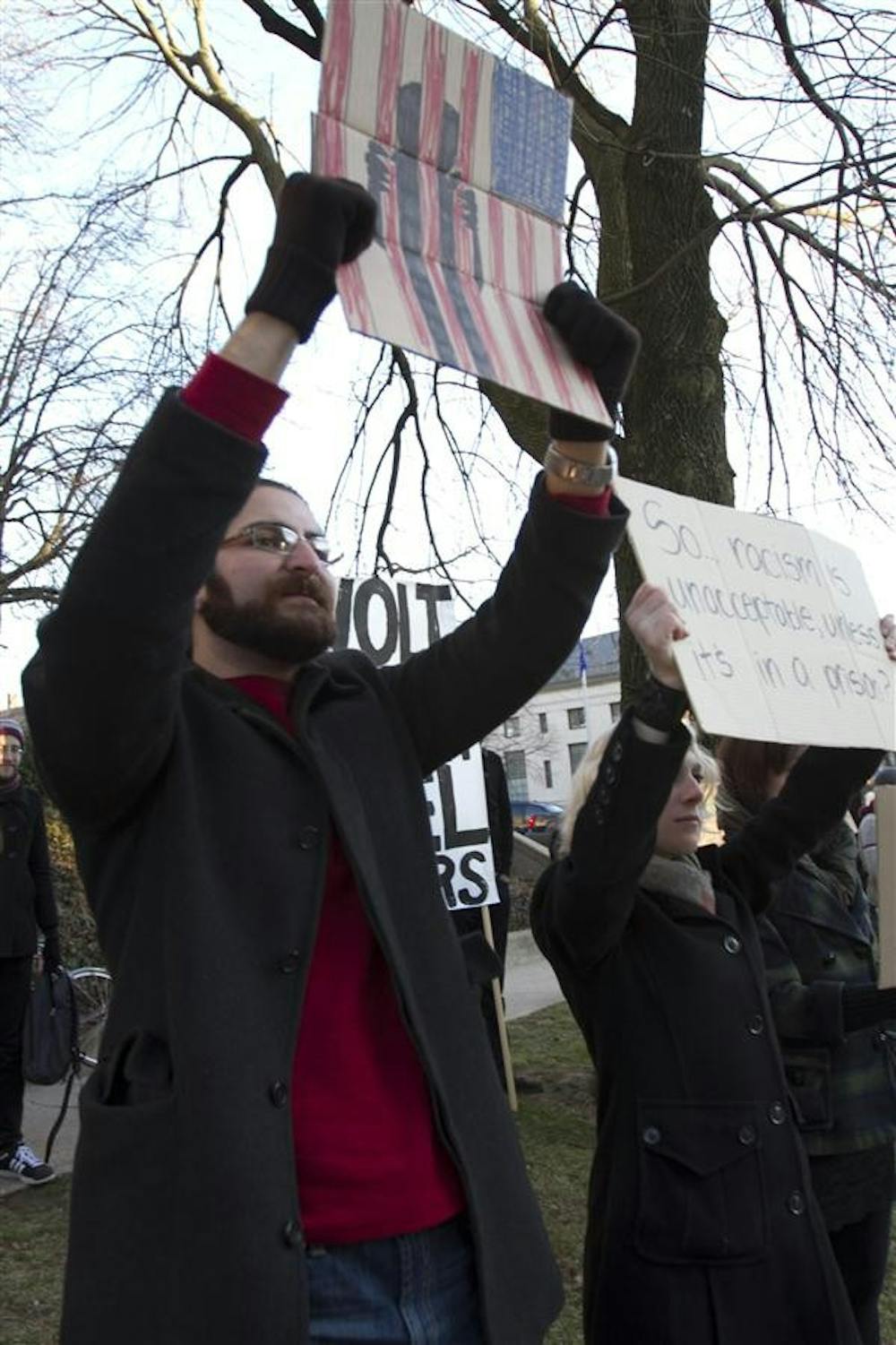Occupy Bloomington protesters were evicted from Peoples Park about a month and a half ago. But Monday evening, demonstrators reminded the Bloomington community they have not gone away.
Unlike in previous demonstrations, protesters gathered with a unified agenda.
“Freedom to the prisoners, fire to the prisons,” protesters chanted across the street from the Monroe County Jail on College Avenue. “Burning mattress, burning cell, tell the guards to go to hell.”
The noise demonstration was a collaboration between the Occupy Bloomington Decarcerate Working Group and Decarcerate Monroe County.
As part of the “National Occupy Day in Support of Prisoners,” organized by Occupy protesters in Oakland, Calif., demonstrators called for solidarity with prisoners, demanding the end of incarceration “as a means of containing those dispossessed by unjust social policies.”
Protesters held a sign painted on a bed sheet reading “imprisonment is a form of torture.”
According to American Civil Liberties Union statistics, Indiana increased its prison population by 47 percent from 2000 to 2010.
Nationwide, 2.2 million Americans are incarcerated, according to the National Council on Crime and Delinquency.
This amount accounts for 23 percent of the world’s incarcerated people, although the United States has fewer than 5 percent of the world’s population.
U.S. prison populations are predominantly African-American.
Protesters wielded cardboard signs reading “no one is free while others are oppressed” and “abolish slavery.” Across the street, the windows of the Monroe County Justice building were black and lifeless.
Breaking open a “value pack” of multicolored whistles, the protesters increased the noise level. Using a tree limb, a woman banged on the bottom of a stainless steel bowl, a blank expression on her face.
“For every life taken by fascism, a life will be liberated by anarchism,” read another cardboard sign.
Among the 40 or so people who gathered to demand decarceration, protester Nicole Johnson spoke into a megaphone.
“We will also shine a spotlight on the local mistreatment of incarcerated individuals in the Monroe County Jail,” Johnson said. “Between 1976 and 2000, the United States built, on average, a new prison each week, and the number of imprisoned Americans increased tenfold.”
Since Occupiers were removed from Peoples Park following a demonstration during New Year’s Eve, during which three protesters were arrested, the group has not been as visible in the community.
Monday’s demonstration was the first time protesters have hit the streets since their removal from the park.
Without the park, Occupy participants have moved their general assembly into the Showers Building outside of the City Council Chambers every evening. Overall, the protesters have divided into smaller subgroups.
“The only thing we lost was a common space, but I don’t really feel like anything has changed except we’re not in everybody’s face everyday,” Johnson said. “Instead of having a group of people who are just discontent about everything, we have smaller groups meeting in houses and basements and coffee shops to talk about specific issues.”
Protester Thea Linnemeier said she is not heartbroken that a physical occupation no longer exists. The real value of Occupy Bloomington, she said, is her ability to network with like-minded activists.
As cars waited at red lights, protesters rushed the streets with pamphlets.
“The passion for freedom is stronger than the prisons,” protesters said, withdrawn at first.
But their intensity built until silence took over completely.
“The key word is passion, y’all,” one protester said.
“Nobody inside can hear us, nobody in their cars can hear us,” one of the protesters said to another. “I’m glad we’re doing it, but nobody is likely to get mad at us.”
Linnemeier said she opposes the incarceration of nonviolent criminals.
As felonies are destroying the personal records of imprisoned individuals, she said, there has to be a better way.
“The occupation was a way to bring people together,” Johnson said. “It’s not a noun, Bloomington isn’t an adjective, it doesn’t describe a thing, it was a place and that place, although it may not be there in physical form, everyone involved is still carrying that around in their heart.”
Today, Occupy Bloomington protesters will join other Occupiers from across the state to protest outside the Indiana Department of Corrections headquarters in
Indianapolis.
Occupiers protest outside Monroe County jail

Get stories like this in your inbox
Subscribe





